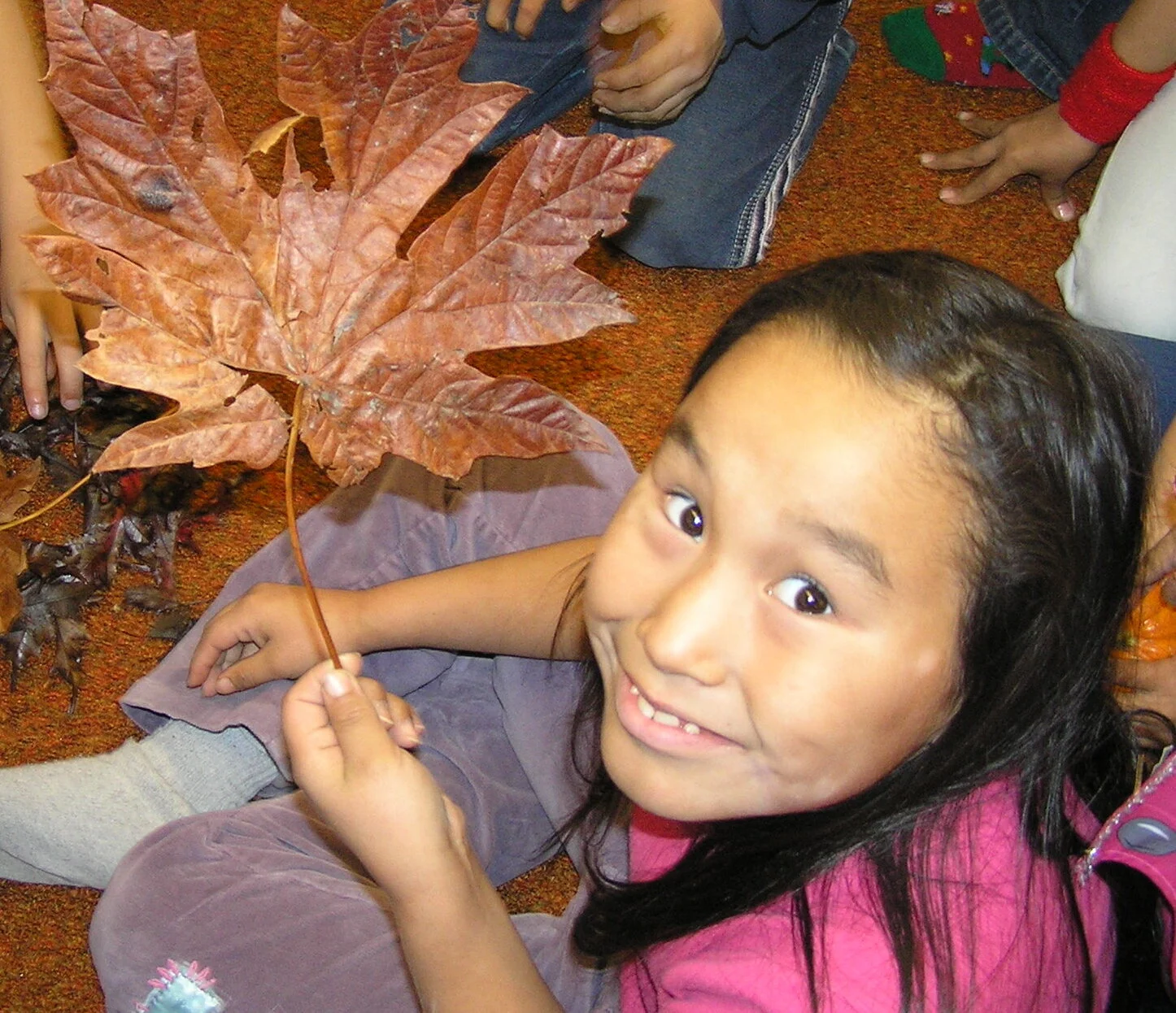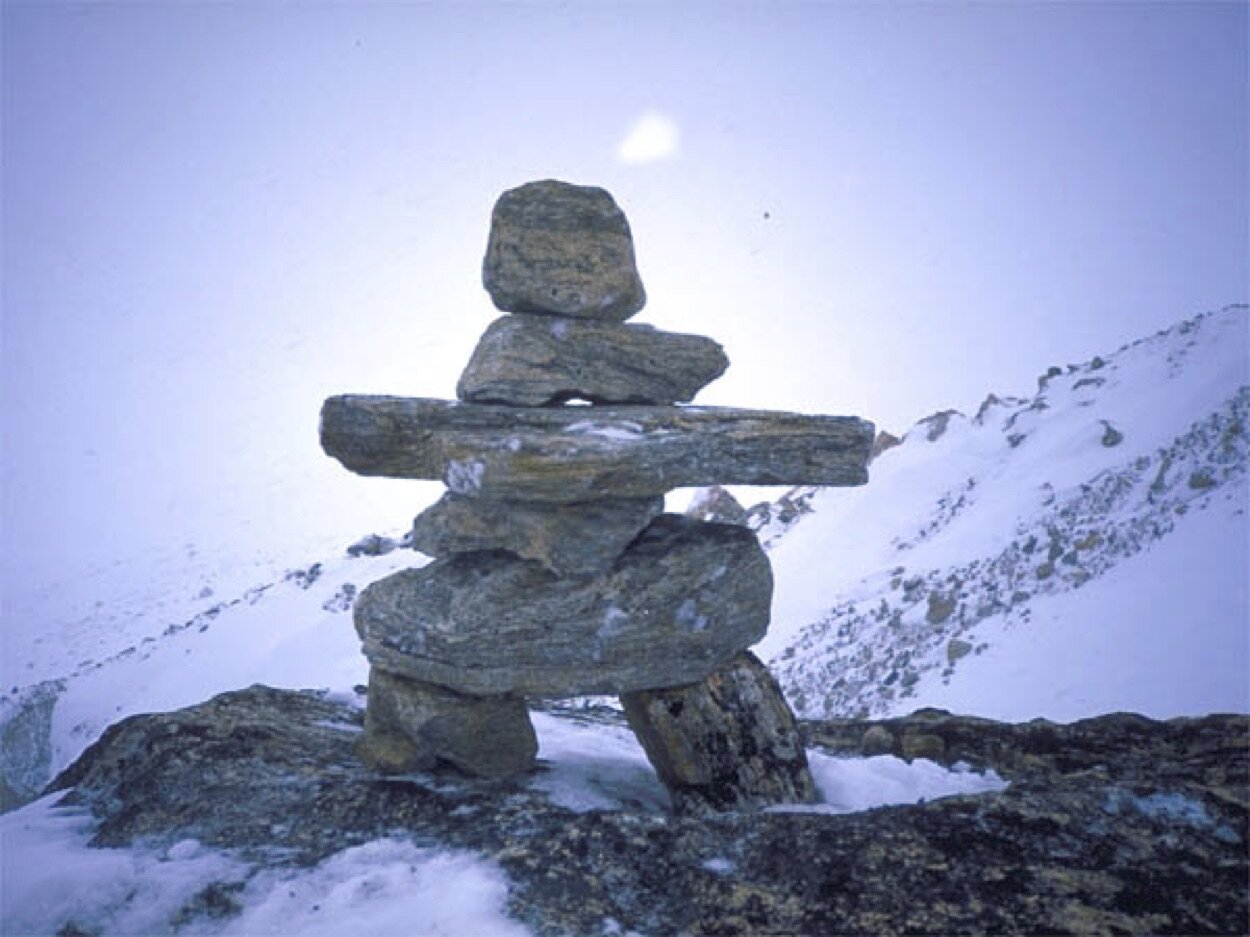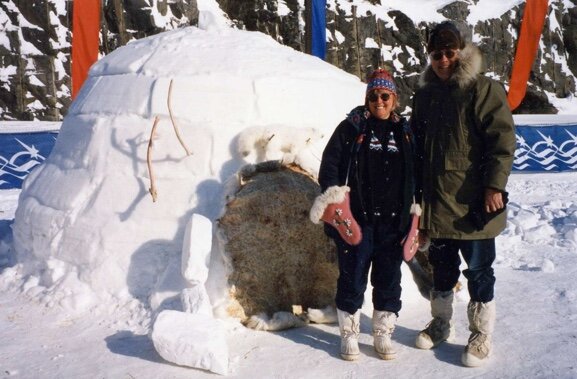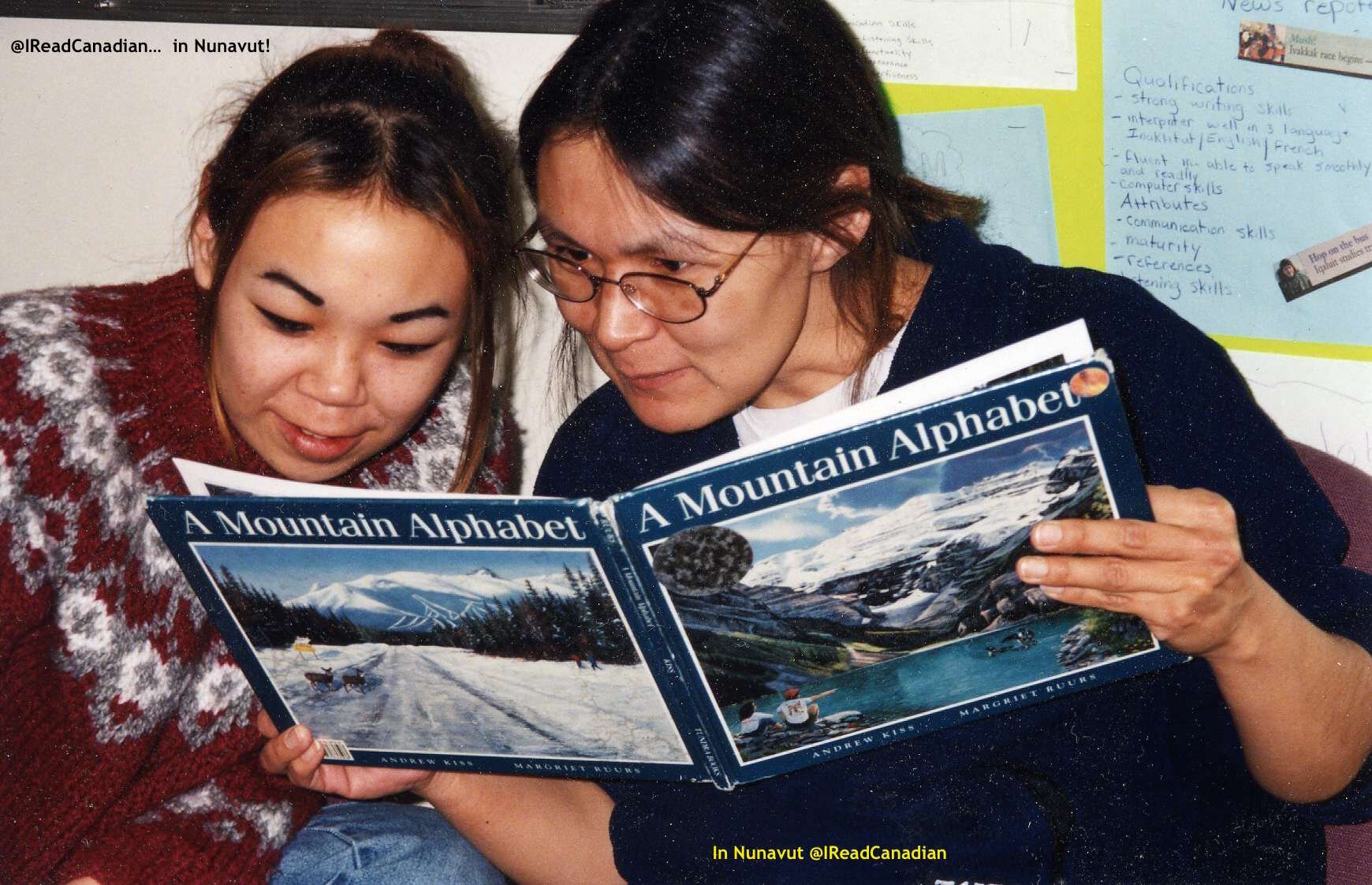An inukshuk shows the way on the tundra.
We have been privileged to travel to, and through, Canada’s most northern territory Nunavut, or ‘Our Land’ as it is called in Inuktitut, the language of the Inuit. We had close friends who lived in Iqaluit, Nunavut’s capital, for a few years. We attended the Arctic Winter Games being held there and I was once selected to do readings in schools and libraries in Nunavut for Canadian Children’s Book Week.
Traveling to Nunavut gives you a sense of the immense size of this country. To reach this special place, I flew from Vancouver to Winnipeg, Manitoba where I stayed overnight. Then on to Churchill, Manitoba the next day. I had no idea that the plane would stop there or I would have made plans to spend a day to see the polar bears. Churchill is famous for its many polar bears around and even right in town. You can take special polar bear safaris in huge vehicles. I was there around Halloween and, to allow local kids to safely go trick-or-treating, they had parked all cars in town in a big circle around the community, headlights facing out, in hopes of keeping the polar bears out of town that night…
During Arctic Winter Games demonstrations Igloo building were held. We sat inside by the warmth of an oil lamp.
The plane to Iqaluit, formerly called Frobisher Bay, was half cargo plane with seats for passengers in the front hall. To my surprise, the landing strip was enormous: 2,620 meters long. I learned that this is an alternate, emergency landing site for NASA’s Space Shuttle program. Not what you expect to see in this land of snow and caribou.
I was excited about this chance to spend time in the Arctic, to meet Inuit people, to learn more about their culture and language. I did readings in the Iqaluit Library where ladies in beautiful fur lined parkas showed up. We even took a bit of a language class and practised our rolling ‘r’ and gutteral ‘g’ - which we already have because we speak Dutch. We visited the Legislature, Arctic College and drove the Road to Nowhere! Most people in this capital city don’t have a car (there are no roads to get up here). Taxis take you everywhere for $5.- a ride. I visited several artists studios of young Inuit painters and sculptors. So grateful to see traditional art making a come back.
I flew in a tiny 4 seater plane to the village Kimmirut on Baffin Island. This was a regular line flight but when the pilot heard that this was my first visit to Baffin Island, he enthusiastically called, “Let’s go looking for polar bears!” and followed the ice and tracks in hopes of spotting one from the air. When the airplane buzzed the school, the principal knew it was time to pick up the visiting author and jumped on his snowmobile. I was glad I didn’t wear a skirt.
Nothing is wasted when seal skins are used.
I stayed with the principal and his wife and loved the children who waved at me everywhere when I walked through the village, crunching snow under my boots and huddled deep inside my warm winter parka.
An elder who is an artist.
“Margriet!” the principal’s wife called as soon as I came home one day after school, “come quick! The elders have invited you to see a polar bear getting skinned!” There had been a polar bear hunt just before I arrived and now the enormous animal was being skinned. It was a rare privilege for me to witness this traditional event. Spread across the entire kitchen floor lay a rust coloured bear, not the pristine white I had imagined . It was carefully being stripped off its thick coat with the use of a traditional ulu knife. The thin, curved metal blade slid between fur and skin, deftly separating the two layers. Not a thing was wasted. Meat, fur, sinew - everything is being used and the Inuit respectfully thank the animals for their sacrifice in sustaining them. Same with seals. They provide not only food but warm, insulating clothing. It was explained to me that, in this region of the Arctic, when a person succeeds in bringing home their first catch of a certain animal, they give thanks by climbing on the roof of their home and tossing slips of paper into the air. Neighbours gather and catch these pieces of paper, then claim the gift offered to them. The successful hunter shares his bounty with the community by giving away things that are needed - matches, pieces of soap, etc.
“Any minute now,” said the principal when I had first arrived at his home, “there will be a knock on the door and someone will bring an arctic char or a piece of caribou meat. They know I am hosting a visitor from outside and it is the community’s responsibility to feed a visitor.” At school, just as we’re entering the High School classroom, he tells me, “Now remember, these kids have never sat in a car and they’ve never seen trees.” It blows my mind and makes me realize how vast differences on our planet really are. And we even live in the same country.
In Rankin Inlet I was met by the librarian from the Ayaruaq Public Library and taken to the B & B where I would stay. I told the owner that I hoped to see Northern Lights. “Then you are in luck,” she smiled, “because I live next to the cemetery.” Only because I had been to the Arctic before, did I know that it is an ancient Inuit belief that the Northern Lights are the spirits of the dead, best seen shortly after someone passes on.
An hour after I arrived I was at a local coffee house for storytelling, a fundraising event for Literacy in Nunavut, coordinated by well known Inuit children’s book author Michael Kusugak. I had met Michael down south, so it was wonderful to get reacquainted in his own environment. Michael is the author of many books, including A Promise is a Promise with Robert Munsch. We set off for the Public Library for a reading. Despite a cold and howling wind, some eighty people showed up. I had brought Halloween candies and an entire pumpkin with me in my luggage. Having been up north before, I knew the cost of those specialty items was prohibitive up here. A medium sized pumpkin flown up cost $50.- in the Rankin store!
Bundled up for -40º
Michael picked me up on his dirt bike. There are almost no cars in town, everyone rides dirt bike around town until the snow falls and they can ride snowmobiles again. There wasn’t any snow on the ground now, which worried people. The caribou are not coming until the snow falls and global warming is causing major changes here. He laughed, “We call this a Honda. Even though my Honda is a Bombadier, it is still called a ‘Honda’.” I climbed on and huddled behind Michael’s back as we roared across town in the biting wind. I wore borrowed snow pants, a fur lined parka, my hat, scarf, gloves and mitts. But it was still very cold. The ride was very, very bumpy across rocky tundra with no snow to smooth out the bumps.
Soon we were out “on the land” - everything outside town is called ‘on the land’, the bare tundra. Besides a house in town, many people have a small, square cabin outside of town, often near a lake where they go to hunt and fish.
My teeth chattered and my hat kept falling over my eyes. I couldn’t let go of my hand grips... But it was an experience of a lifetime so I savoured it all. We spotted a snowy owl, a flock of pure white ptarmigan and a peregrine falcon on its nest. Small inukshuks, traditional rocks piled into the shape of a human figure, showed the way. I was glad to know that Michael, whose original name is Arvaarluk, knows this land like no other. Michael is the same age as I am, but he told me that he remembers when white men first came and told them they had to pick a last name and assigned them a Christian name. He went from being Arvaarluk to being called Michael. Kusugak was his father’s name which he chose as a last name. He also remembers living in a sod hut in the summers when they followed the caribou. The Inuit lifestyle remained untouched for centuries until the missionaries arrived in the 1960’s. That evening I enjoyed a northern supper of caribou stew at Michael Kusugak and his wife’s home. Fresh vegetables and fruit are scarce and terribly expensive.
During my time off, between readings, talks and workshops, I explored town and took photos. I was followed around by puppies that run rampant. Almost each house has dogs tied up to the piling (houses are built on stilts on top of the perma frost), and a qamutiik, a flat sled, next to it.
School author presentations here are interesting. The kids are keen and enthusiastic, but no one told me what time my presentations will start. Each time I ask, the answer is “When you get here...” The time frame up north is wonderfully relaxed. I started my presentation once I was all set up, when my projector was plugged in. Only then did they call the kids down. I’m so used to rushing, racing to get it all done in time or the kids are already waiting. This was a great way to do it, I never once felt rushed or harried.
Inuit kids love books!
The students in the elementary school are very keen and excited by my books. But the biggest hit is when I show them what else I brought: a large ziploc bag full of wet fall leaves. I gathered brown and yellow maple leaves at home. Their reactions, as I pull a leaf out of the bag, bring tears to my eyes. “I have never seen a leaf!” 12 year old Maggie whispers, holding out her hand to touch the leaves. They are passed around by Grade Six students as if they were precious jewels. Big, tough boys put their nose down on the leaves to inhale the smell.
After school I walk to the local art gallery and buy a newly made print from a young Inuit artist. That same night I fly to Baker Lake, Nunavut. No security checks, no assigned seating on the planes. You just take what you need and get on. When I walk up to the counter in the terminal, Adam, the son of the people I just had dinner with, works there. He doesn’t even ask my name but hands me my boarding pass. I’m impressed. Then he walks me to the plane. Turns out I’m the only passenger on the flight. The runway is unpaved gravel. It’s a short 40 minute flight across dark, frozen tundra.
Going to school on a dirt bike.
The local public librarian is my host in Baker Lake. After a night with brilliantly dancing Northern Lights, a low northern sunrise paints the lake and snowy land soft pastel shades of pink. It is still dark when I climb on the back of her Honda dirt bike the next morning. Huddling behind Susan, I try to keep my scarf and hood around my face to protect me from the biting wind. Tied to the front of her dirt bike is a cardboard box holding my books and equipment. We make our way down the main road of Baker Lake along the shore of the frozen lake. People wave. They all know that the stranger in town is here to tell stories in the Library. It’s been on the radio many times. The radio here is used like a telephone and a message board. A song will be playing when the phone rings, on the air. “Hello?” says the announcer. And someone may say “This is Johnny. Can Marie please come see me?” When he hangs up, the song continues. Then the phone rings again. It is Susan announcing that the visiting author will be speaking at the Library tomorrow night. The song continues for a minute but is once again interrupted by the phone. George Kavaluq has a washing machine for sale…
Inuit adult students used my alphabet books in English class.
My presentations take place in Arngnammaktiq Elementary School. Janet, the only teacher/librarian in all of Nunavut, has prepared the students well. They are keen and curious, excited to meet the Kabloonaq (white) visitor. Janet has been reading to them and, even though books are not part of their cultural heritage, the children love stories. Until quite recently, the Inuit led a nomadic lifestyle. This did not allow for a house full of books. We discuss books, I show them how I get ideas for stories and they love telling their own tales.
No trees in Nunavut so the leaves I brought are a novelty.
On the morning when I have to travel to the next town, the taxi arrives at 7 AM. We asked for a taxi to “Susan’s place.” Even though there are some 1,500 people in town, the taxi drivers know all houses by the occupant’s name. There are no street addresses. Each house has a bright red lamp burning out front. If the light goes out, it is a signal to the water truck to come and refill the water tank. At the airport, the high school soccer team is waiting. They have a competition in another part of the Arctic and fly there. A group of giggling girls comes to shake my hand, they all know I’m the visiting author.
Next I fly to Arviat, Nunavut where the public librarian and teacher, Marleen, are waiting for me on dirt bikes. I won’t be staying overnight so I leave my suitcase at the airport, just somewhere in a corner.
Between school presentations, Marleen takes me home for lunch. Her husband keeps looking out the window to see if there might be a polar bear walking by on the ice. They even send me home with a large, frozen arctic char. When I get to the airport, my suitcase is already on the plane (they knew it was mine!) but they retrieve it so I can stuff my char in the front pouch so it will stay frozen.
Then I say goodbye to the north... this strange, wonderful, mystical, frozen land full of warm people, warm smiles and kind friends, taking memories and gifts back to the south. Nunavut will always have a special place in my heart.
Check out Michael Kusugak’s books and CD's, which include stories and throat singing: http://www.michaelkusugak.com
The Arctic Winter Games are an amazing opportunity to see traditional sports in action, like the One Foot High Kick, the Ear-Pull, the famous Blanket Toss and listen to throat singing: https://www.arcticwintergames.org/
Books about Nunavut












